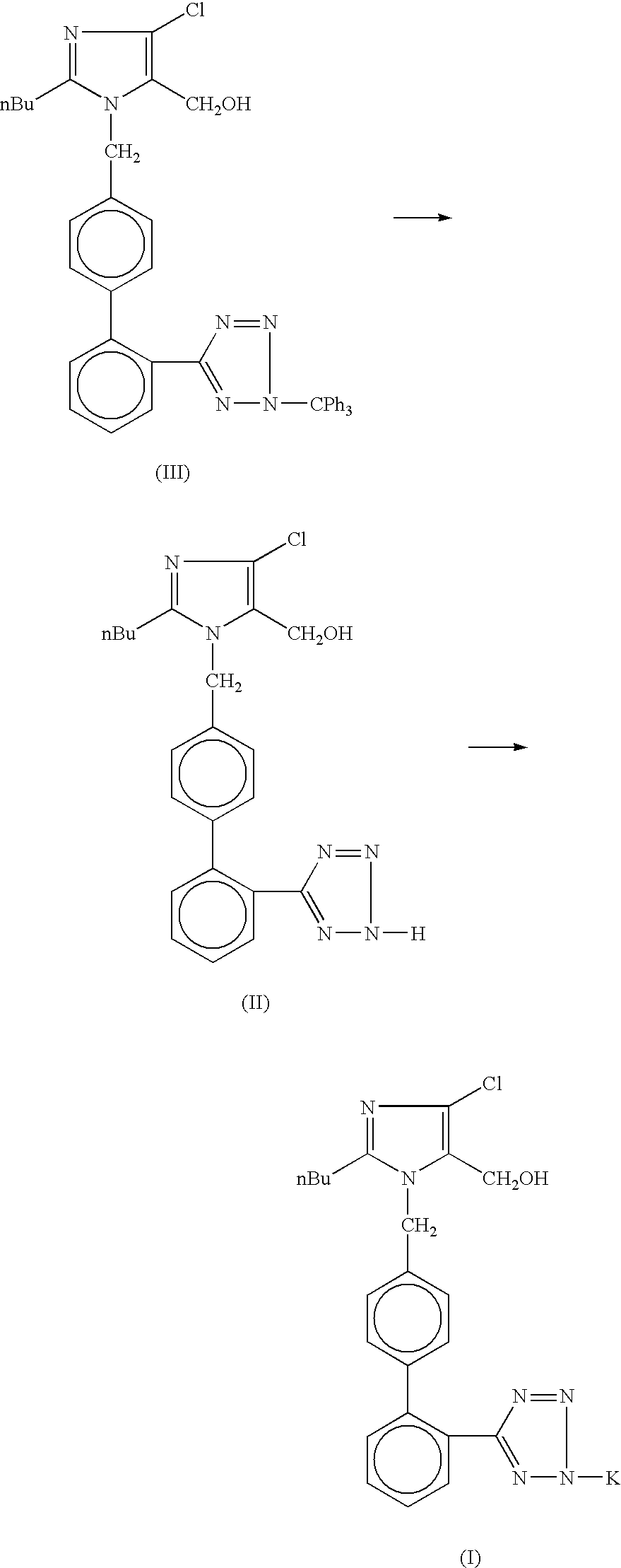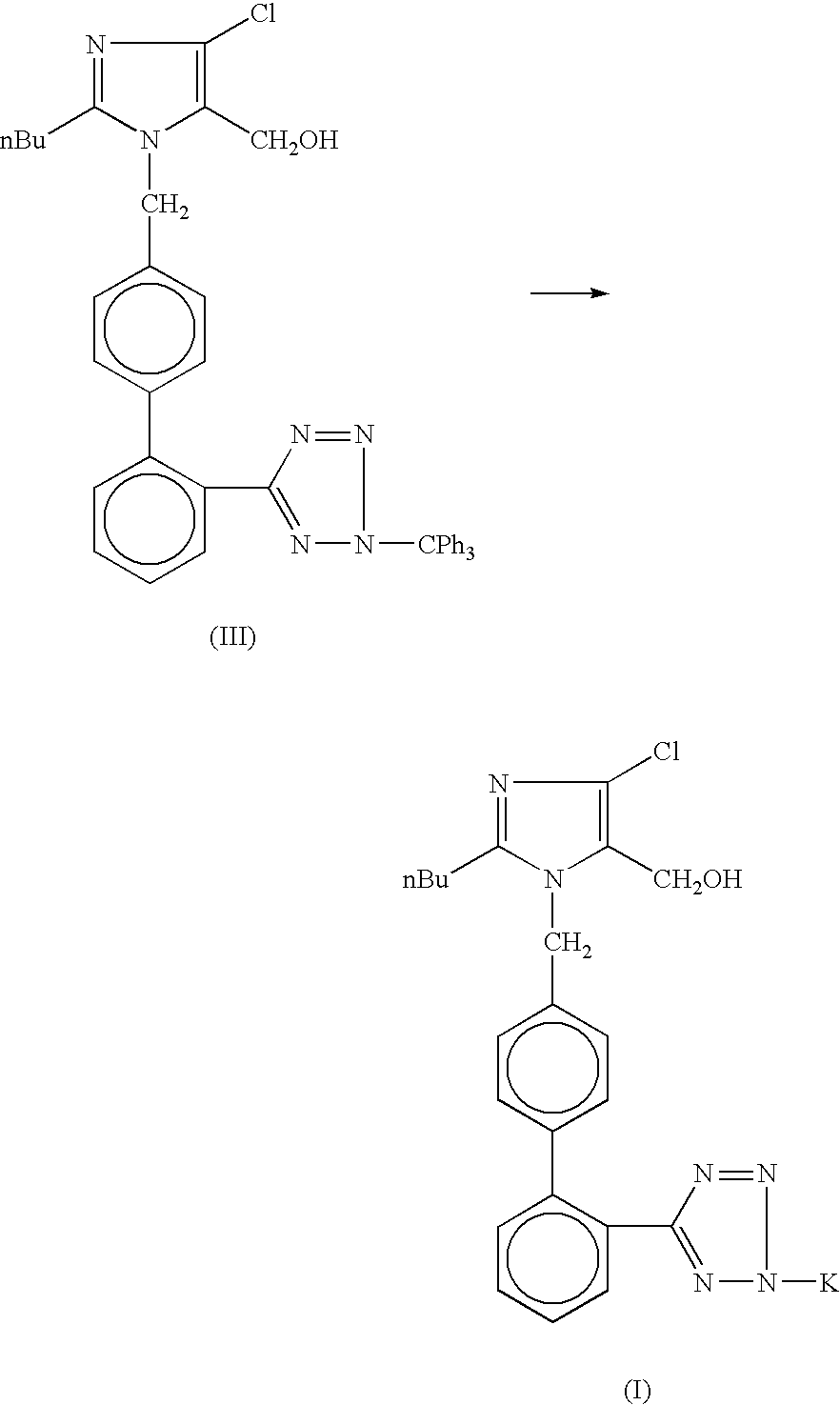Losartan potassium synthesis
a technology of losartan potassium and synthesis process, which is applied in the field of synthesis of losartan potassium, can solve the problems of fractional distillation of mixed materials, and achieve the effects of reducing solvent usage and loss, high purity, and easy recovery and reus
- Summary
- Abstract
- Description
- Claims
- Application Information
AI Technical Summary
Benefits of technology
Problems solved by technology
Method used
Image
Examples
example 2
[0025] Under nitrogen atmosphere in a 500 ml flask, a solution of potassium tertiary butoxide (8.44 gm, 0.075 mole) in methanol (275 ml) is prepared. To this solution, 50.0 gm of trityl losartan (0.075 mole) is added and refluxed for 8 hours. The completion of reaction is monitored on TLC. The reaction mass is concentrated to 50% and cooled to -5.+-.2.degree. C. The by-product is removed by filtration. After charcoalisation, the filtrate is filtered through celite. Methanol is distilled out until a sticky mass is obtained. Isopropyl alcohol (75 ml) is charged and cooled to 30.degree. C. This reaction mass is kept for 12 hours and then it is cooled to 0-5.degree. C. The product (Losartan Potassium) is filtered and washed with chilled isopropyl alcohol (15 ml). The final product is dried at 45-50.degree. C. under vacuum for 6 hours to remove residual isopropyl alcohol. The percentage yield of Losartan Potassium is 78%.
example 3
[0026] Under nitrogen atmosphere in a 500 ml flask, a solution of potassium tertiary butoxide (8.44 gm, 0.075 mole) in methanol (275 ml) is prepared. To this solution, 50.0 gm trityl losartan (0.075 mole) is added and refluxed for 8 hours. The completion of reaction is monitored on TLC. The reaction mass is concentrated to 50% and cooled to -5.+-.2.degree. C. The by-product is removed by filtration. After charcoalisation, the filtrate is filtered through celite. Methanol is distilled out. Terahydrofuran (200 ml) is charged and refluxed for 1.0 hour. The reaction mass is cooled to 30.degree. C. and stirred for 5 hours. The reaction mass is cooled to 0-5.degree. C. and filtered. The product (Losartan Potassium) is washed with chilled tetrahydrofuran (15 ml). The final product is dried at 45-50.degree. C. under vacuum for 6 hours. The percentage yield of Losartan Potassium is 90.62%.
example 4
[0027] Under nitrogen atmosphere in a 500 ml flask, a solution of potassium tertiary butoxide (8.44 gm, 0.075 mole) in methanol (275 ml) is prepared. To this solution, 50.0 gm trityl losartan (0.075 mole) is added and refluxed for 8 hours. The completion of reaction is monitored on TLC. The reaction mass is cooled to -5.+-.2.degree. C. and the by-product obtained is filtered away. After charcoalisation, the filtrate is filtered through celite. Methanol is distilled out completely and stripped out using 25 ml of isopropyl alcohol. Isopropyl alcohol (75 ml) is charged and kept for 12 hour. The reaction mass is cooled to 0-5.degree. C. and filtered. The product (Losartan Potassium) is washed with chilled isopropyl alcohol (15 ml). The final product is dried at 45-50.degree. C. under vacuum for 6 hours. The percentage yield of Losartan Potassium is 79.95%.
PUM
| Property | Measurement | Unit |
|---|---|---|
| Mass | aaaaa | aaaaa |
| Crystallization enthalpy | aaaaa | aaaaa |
Abstract
Description
Claims
Application Information
 Login to View More
Login to View More - R&D
- Intellectual Property
- Life Sciences
- Materials
- Tech Scout
- Unparalleled Data Quality
- Higher Quality Content
- 60% Fewer Hallucinations
Browse by: Latest US Patents, China's latest patents, Technical Efficacy Thesaurus, Application Domain, Technology Topic, Popular Technical Reports.
© 2025 PatSnap. All rights reserved.Legal|Privacy policy|Modern Slavery Act Transparency Statement|Sitemap|About US| Contact US: help@patsnap.com


